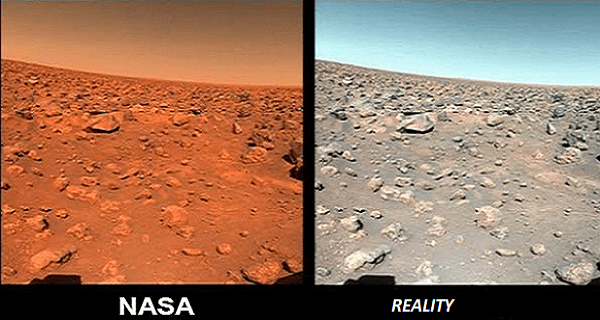I was curious so I traced what image that is. It's from a website that when searched in google yields:
"Soul:Ask | Unlock your mind and soul · Aliens & UFO's · Spirituality · Ancient · Conspiracy Theories · Fact or fiction · Ghosts & Hauntings · Paranormal · Mysteries · Underworld · Apocalypse & Armageddon · Occult · Bizzare & Odd · Metaphysics & Psychology · Planet Earth · Science & Technology · Cryptozoology · Space."
Given that list of things, I'm not really sure I'm going to trust the validity of someone (that is, the creator of that image) claiming to have The Real Truth about what Mars looks like to human eyes. I suspect you didn't pick that as your source intentionally - a google search probably yielded a picture like what you were looking for.
Regardless!
It looks like someone used a filter on the "Reality" side to remove a lot of the red; what that means is that the "Reality" side of that image is showing what the dirt would look like if your eyes were less sensitive to the red portion of the spectrum (allowing you to see more of the blue/green/etc details). Neat! ... but that isn't really reality. It's just a color correction for "what if our eyes were adjusted* for Mars rather than for Earth" As it is, if I was teleported to Mars today, I'd expect to see the NASA side, and not the "Reality" side.
* By adjusted, you can mean created, evolved, whatever. The point is that our eyes see the color frequencies they do because they are helpful to us. Just like animals with an infrared-biased sight spectrum enjoy the benefits of seeing better at night, our eyes are highly effective at seeing during the daytime on Earth through our atmosphere - and not really effective on Mars, where they're flooded with the red spectrum and won't be able to see all the fine color details they could on Earth.
EDIT: For * explanation, and to make sure I was being clear about whose credibility I was judging (the website, not the OP)




